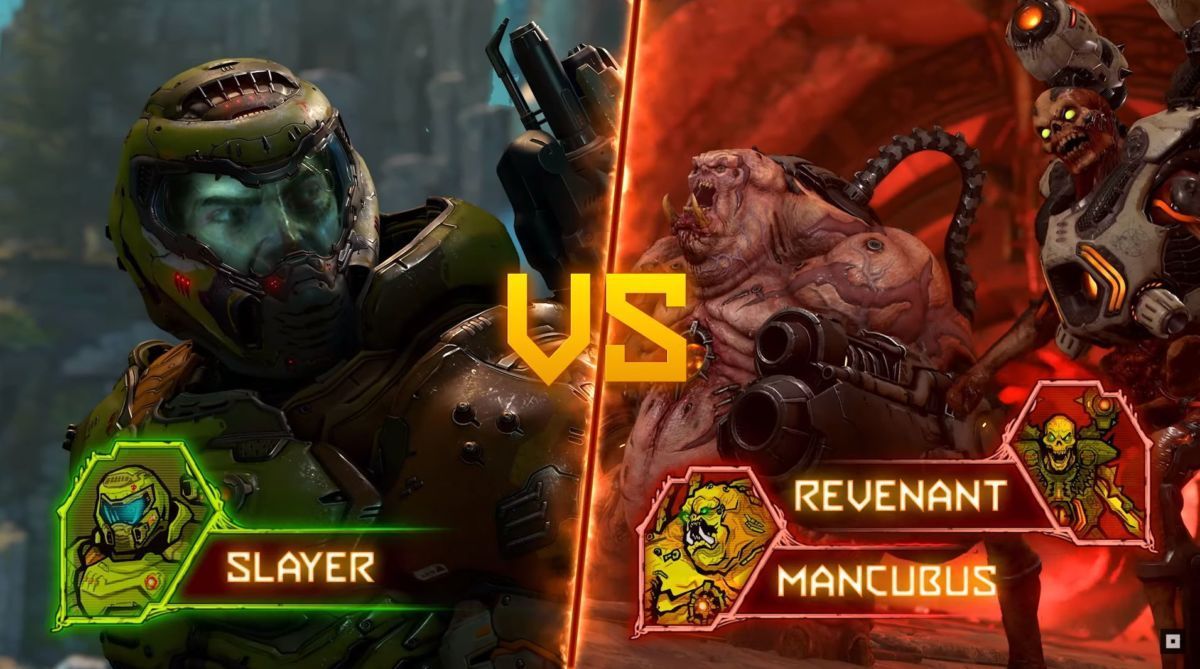id Software is Evolving Doom and Wolfenstein for the Era of Streaming
The teams at id and Bethesda are slightly changing the formula for their classic franchises. Let's break down how, and why.

The teams at id and Bethesda are slightly changing the formula for their classic franchises. Let's break down how, and why.
E3 2019 is in its final days, and over the weekend the gaming world bore witness to myriad new looks at upcoming games, some we knew were coming and others being revealed for the first time. Two titles about which we learned a great deal were Doom Eternal and Wolfenstein Youngblood, both story-driven FPS carnage-fests on the horizon from id Software and publisher Bethesda Softworks, and each serving as both entries in long-running, historically relevant franchises and sequels to recent and well-regarded incarnations.
The excitement around these titles is palpable, and with their predecessors already critical and commercial successes, the teams behind each game didn’t need to reinvent the wheel to deliver what their audiences want. Still, there are notable changes coming to the worlds of Doom and Wolfenstein, and many of them seem to be oriented towards a particular goal: giving the game a longer lifespan, not just for its players, but in the increasingly vital world of streaming. Within this context, a look back at id and Bethesda’s most recent titles reveals where those games might have come up short, and how that has informed the manner in which they’re updating these two venerated franchises.
Wolfenstein II: The New Colossus, October 2017
The second entry in the most recent incarnation of the Wolfenstein franchise was released to great acclaim on October 27, 2017. As visible in the graph above, this was the single most prolific day for the game on Twitch, reaching a peak of just under 80,000 viewers across 334 channels. Let’s compare the graph above to performance of other titles released around the same time. Below, on the left we have the total viewership of Assassin’s Creed Odyssee, released on the same day as Wolfenstein, and on the right is Destiny 2, released on September 6th of that year.
Direct comparisons are far from a perfect way to capture all of the context, but it does illuminate some things. Assassin’s Creed is a very different title than Wolfenstein, with an expansive open world and myriad optional activities, in contrast to the latter title which is rigidly structured by levels to deliver a tight narrative. But, they’re also both single player titles from AAA franchises that each continue a long running and critically acclaimed series focused primarily on experiencing a story. It’s interesting, therefore, that while each game experienced similar peak viewership off the bat, Wolfenstein fell to an average below 1000 viewers by November 16th, while Assassin’s Creed didn’t fall to similar levels until December 7th, twenty-two days later. This speaks to the natural advantage the latter has due to its genre, the open world, wealth of side-missions, and flat-out longer narrative lending itself to more personalized play sessions and longer periods of engagement.
But, of course, neither reaches anywhere near the heights of Destiny 2, which reached a peak of over 100,000 viewers on its first day and over 200,000 within the first month and a half. There is, of course, no comparison between a story-driven solo title with a finite end and the endless potential of an online looter shooter experiencing constant updates to an ever-changing world. Instead, this simply illustrates the disparity between these two broad categories of titles in the current world of gaming, where a prolonged drip-feed of content and “infinite gameplay” creates Twitch juggernauts in the form of titles like Fortnite and League of Legend. These more narratively focused, single-player games won’t ever carve out audiences of that magnitude on Twitch, and they shouldn’t hope or expect to, as “success” is a measure unique to each genre and each individual game. But, there are lessons within these other genres that the teams behind id Software’s titles can put into practice to increase the longevity and “streamibility” of their games. One such lessons is being put into practice soon for a title which was recently released: Rage 2.
Rage 2, May 2019
Rage 2 was released on May 14th of this year, and reached slightly higher peaks of initial viewership compared to Wolfenstein: The New Colossus, climbing to just under 100,000 total viewers in the first hours on the market. It’s important to remember that Twitch, and streaming in general, have experienced massive growth since the latter parts of 2017, and with that larger platform of streamers and audience-members a game will naturally reach a larger audience. More informative is the rate at which those viewers moved on, with the title reaching an average of under 1000 peak viewers each day by May 27th, only thirteen days into the title’s lifespan. Wolfenstein lasted an additional week, twenty total days, before reaching similar levels.
The plan to counteract this downturn, however, was revealed over the weekend at E3, with the announcement of free weekly content updates and the Rise of the Ghosts expansion, set to hit at an unspecified time later this year. Wolfenstein saw a season of DLC, with three self-contained stories featuring new characters released in the months after the main game. These missions, however, had the same problem as the rest of the title when it came to streaming: they were story based, tightly paced, and relatively short. These were a huge gift to fans of the game, and no doubt they sold well, but they didn’t do anything to make the game more streamable or increase the lifespan of its online community. The forthcoming DLC might, too, be story-based and self-contained - we don’t have the details at this point - but the forthcoming weekly content releases are different. This is the way modern games tend to be supported, with new weapons, missions, and challenges being revealed at a regular pace to keep the game’s audience, both players and viewers, engaged. Will it lead to a resurgence for the title on Twitch? Only time will tell. But, clearly, this is evidence of the team taking lessons from the genres that outpace them in the streaming space and applying them to their own game. And that attitude is also reflected in how id Software is approaching the two forthcoming titles mentioned above.
Doom Eternal and Wolfenstein Youngblood
Both of these games are popular with players because they understand their own identity. They don’t need to become Fortnite or Apex Legends to make a big splash, and if they changed too much to meet the demands of fans of other games it would only serve to alienate the audience they already have. It’s clear from the changes that are indeed on the horizon that the teams behind each title know this well. Looking at the trailers, we see the same ultra violent, fast-paced, empowering combat that made Doom so refreshing when it released in 2016, and the same irreverent attitude and richly detailed alternate history which Wolfenstein fans have come to know and love. But, you don’t need to look hard to see the way the state of the gaming space is changing the approach of both franchises, just a bit.
Put simply: it’s the multiplayer.
Even though a patch was eventually released to add a classic “deathmatch” game mode, and the presence of a scoring system and time trials allowed for an additional competitive element, multiplayer and community was not the focus of 2016’s Doom. The same is definitely true today, as Doom Eternal is still a story-driven, solo experience that’s all about the player embodying the power and ruthlessness of the titular Doomslayer. But, the development team has also created a unique and novel multiplayer mode called ‘Battlemode,’ detailed in the video below.
This is not an obligatory, tacked-on element added to the game because it simply “should be there.” If that had been the team’s goal, adding deathmatches and other classic competitive game-styles would have been plenty. Instead, the team has taken the time and care to build something new, something that fits the tone of the base game, but is much more oriented towards maintaining an engaged community, towards that concept of “endless gameplay.” And, it stands out, with what we’ve seen of the mode presenting an intriguing mix of strategy and brute force about which we’re anxious to see more. And, it additionally seems to present ample opportunity for additional content, perhaps released on a regular basis as is planned for Rage 2. The team could release new monsters with which to play and fight, new arenas, new game modes, and probably more. It, of course, won’t support the sort of online community the heavy hitters of the “live-service” game space have managed to accumulate, but it’s new and interesting and represents a way the latter’s mechanics can really work specifically for Doom. If this game mode catches on with players, it should dramatically increase the lifespan of the game on Twitch.
Looking at Wolfenstein Youngblood, the way in which this title represents change is even more obvious: it’s designed for co-op play. This upcoming game sees the franchise moving on from the series’s long-tenured protagonist B.J. Blaskowicz as its main character, and instead focuses on his twin daughters, Jessica and Sophia, and players can team up with others, each inhabiting a different sister, to tackle the game together. This doesn’t present the opportunity for endless play like Doom’s multiplayer offering, but it does dramatically impact the game’s streamability for creators who collaborate with other streamers. One of the most effective strategies content creators have at their disposal for growing their platform and brand is by teaming up with other channels and allowing their audiences to cross-pollinate. There’s a long history of popular streamers playing together, either in an informal setting, getting pairs or groups together ad-hoc, or as formal “stream teams,” and those that work with other creators tend to reap real rewards, their content becoming more dynamic and unpredictable due to the presence of other streamers, and new viewers watching and following them who wouldn’t have even known they existed otherwise.
This game mode empowers creators to lean in to those strategies. No doubt, when the title releases, major names in the Twitch space will team up to tackle this game together, and it will lead to highly successful streams. Others will team up with smaller streamers, using the game as an opportunity to lift up other voices in the space, or even play with their viewers, offering the chance to play together as rewards for Twitch or Patreon subscriptions. None of this will single-handedly turn the game into a streaming sensation, but it definitely provides more opportunity in that space than its predecessor, and it did it without sacrificing its solo playability or its overall tone. Again, it doesn’t change what Wolfenstein is, and thank goodness for that. But, it does indicate that the franchise is growing with the world of gaming that shifts around it. Looking forward, it’s clear that id Software and Bethesda want to expand their titles’ online reach and community. The steps they’ve taken are in a positive direction.
Be sure to check out what's rising and falling in the world of streaming in our weekly #Top5OnTwitch, and to read our breakdown of how Phoenix Point is evolving the XCom-like genre and creating something perfect for streams. You can also follow us on Twitter and LinkedIn for all the latest blogs, announcements, and game marketing news from the team at GAMESIGHT!

